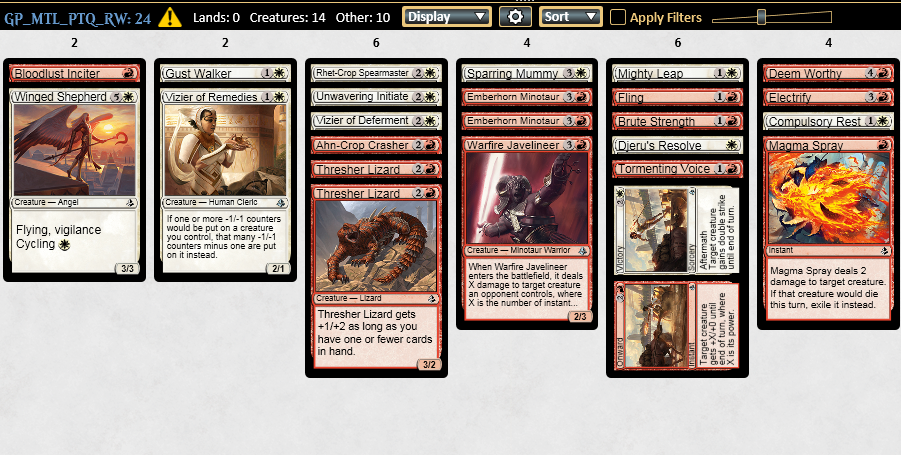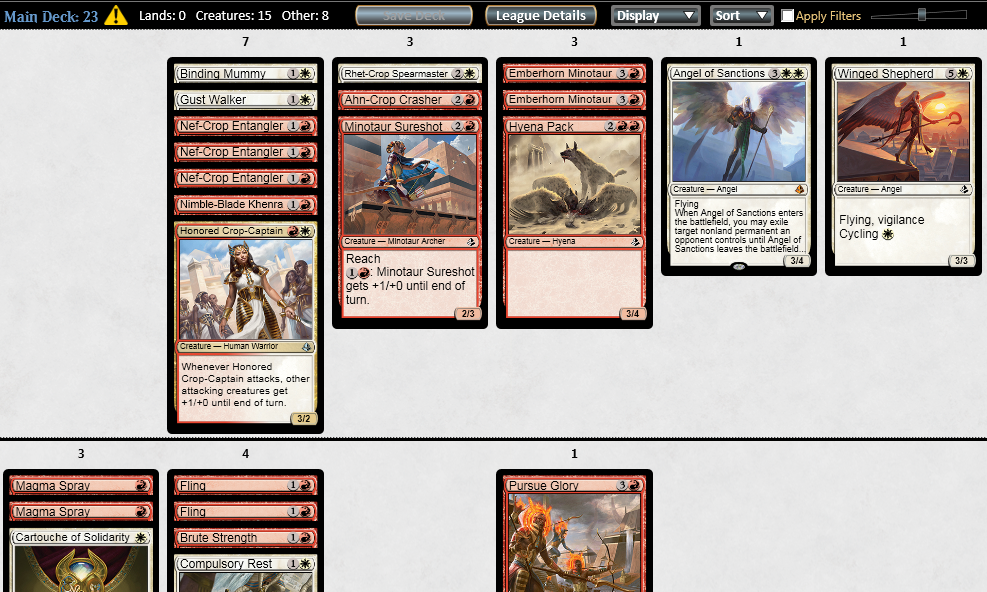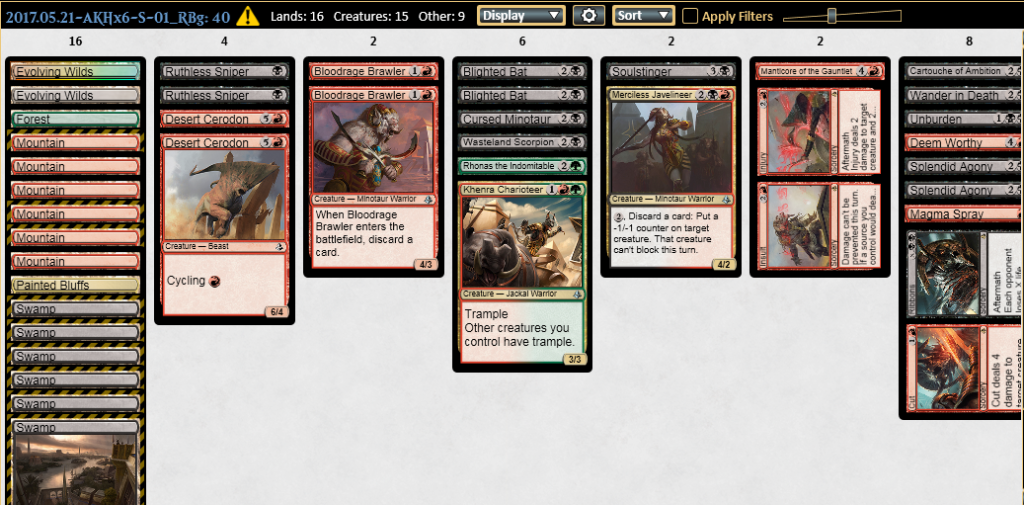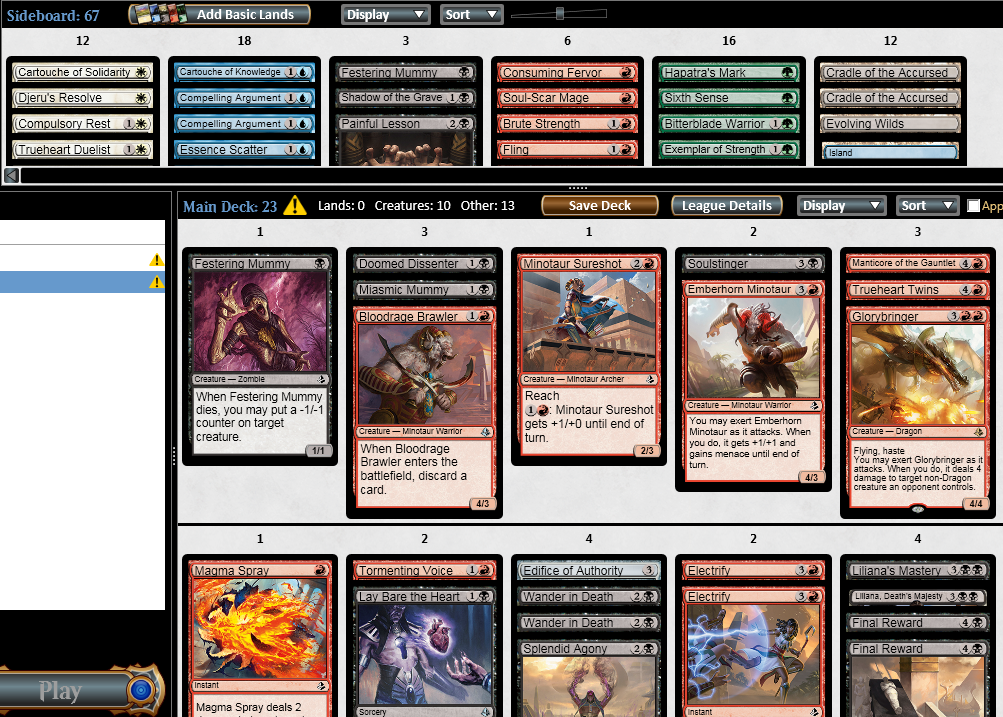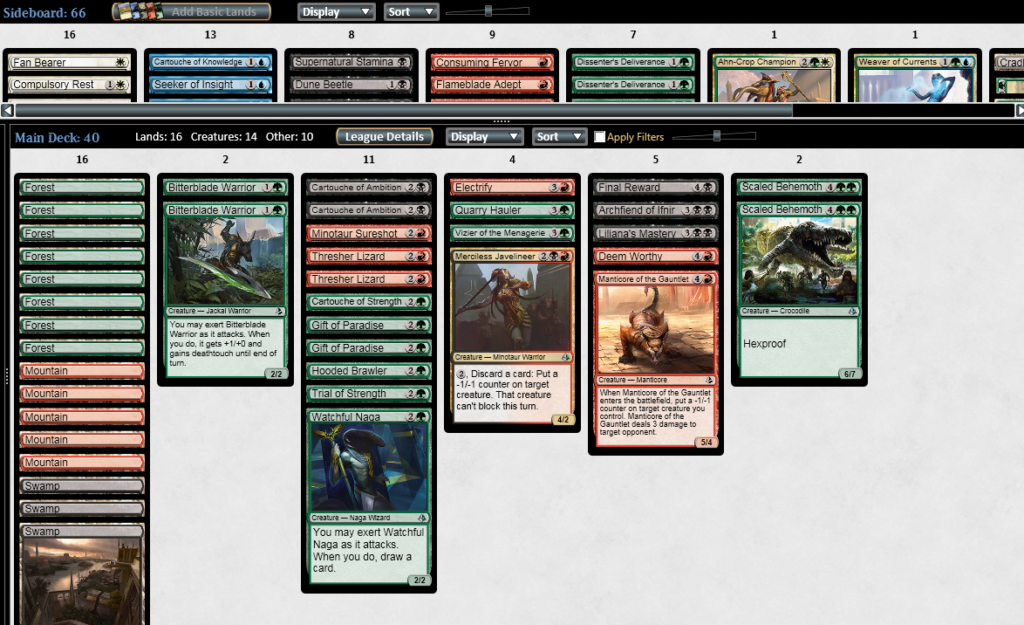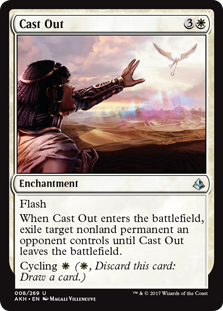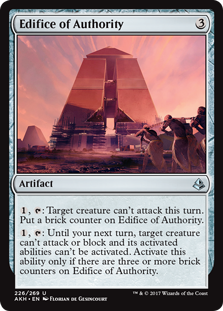This weekend I’m in Toronto for the RPTQ. It’s been a long time since I’ve been qualified for one so I’m excited to be back. The last RPTQ I went to was a year ago which was the last time it featured a sealed format. Playing limited is always my preference, but I’m especially relieved that my Pro Tour fate isn’t going to be tied to spinning Aetherworks Marvel.
The PPTQ/RPTQ system has its ups and downs. Winning a PPTQ is actually pretty hard; even if you’re a very good player, coming in first at any event is no trivial task. But now that we’re here at the RPTQ, all it takes is to spike one small event and you’re headed to the PT.
I’ve been doing a lot of sealed practice for the event. Once I’ve played a format a lot, I like to take a step back and review the decks that have been working for me and others to get a big picture view of the format. Looking at the format from the top down will give me an idea of what I’m looking for when I sit down to build my pool on Sunday.
Sealed Practice and Sample Decks
The early release of Amonkhet to Magic Online meant that I got some early practice and it paid off with a win at my third sealed paper PPTQ to qualify for next season’s RPTQ as well. I’ve completed 21 Magic Online competitive sealed leagues and played in five sealed PPTQ/PTQ events between online and paper. I didn’t record my first couple of leagues, but I kept track of my decks and results for most of the events. I’m going to focus on decks that went 4-1 or better; that’s the record that should be good enough to draw into the top 8 of a normal-sized RPTQ.
Out of 26 events I went 4-1 or better 7 times with an overall win rate of 61.0%. This is a record I’m pretty happy with, especially compared to my Aether Revolt results, so I feel confident in the format going into this weekend.
Impressions of the Format
The first thing that needs to said is that this is a prince format, meaning that decks are powered by their rares. There are some very powerful cards in this set and if you are lucky enough to open one or two of them you should very likely be playing those colors. The removal isn’t great, so bombs are more likely to take over a game. That also means it’s not uncommon to open pools that don’t have a lot of options for removal. Combat tricks have been better than normal for me for this reason.
There’s been an interesting bi-modal split between aggro decks and 3-color decks in this format. With the cycling mechanic I expected the sealed format to be a lot of slow, durdling decks that use cycling to develop their hand and stretch their mana to play multiple colors. However, I have seen a lot of Red-based aggro decks do very well in sealed. In this regard, I’ve noticed a large disparity between the online and paper metagame. Many online opponents I face are playing 3-colors or 2-colors and a splash. In the paper events I’ve done, there have been a lot more 2-color curve-out decks. I think this reflects a difference in player skill between online competitive queues (high average skill level) and local PPTQs (lower average skill level). I’m not sure how to apply this observation to the RPTQ. I expect a wide-ranging mix of player skill with a few very good players and some who don’t usually play limited at all.
Successful Archetypes
The decks I’ve been building and winning with fall into a few categories. I’ll go over each and provide a sample deck.
Red-based Aggro
This is most commonly a RW aggro deck. Both colors have a lot of playable commons and uncommons with a mix of efficient creatures and removal. The best versions of these will have multiple Magma Spray; this is just always a great card, but it’s at its best here when you can double-spell early in the game and use the efficient removal to pressure your opponent and end games early.
RG and RB are less common but do pop up. RG versions are more likely to want Bloodlust Inciter. Rhonas’s Monument has been very good in creature-heavy decks with a low curve (I would even consider it in non-green decks if my curve supported it). RB is a common archetype, but it varies widely from aggro to midrange depending on the pool.
If you open a pool without good rares, this type of deck is your next best bet for success. Rares are a plus, but a good RW deck can win without any splashy bombs. My PPTQ winning deck featured two Trueheart Twins and a good curve of RW exert creatures. The screenshot below was from my PTQ pool at GP Montreal. My rares were so bad that the player who registered my pool handed it back to me saying, ‘I’m sorry, dude.’ I found this scrappy RW aggro/combo deck to be very serviceable, fun to play and took me to a 4-1 record, missing 1st place in my pod (and a spot in the top 8) on tie-breakers.
A more typical RW build would look like this, with a low curve, some removal and one good rare.
Jund Decks
I’ve been building a lot of 3-color Jund variants. Most of these are a 2-color base, splashing the third color. Some pools have good enough fixing that you can play more solidly into straight 3-color. The base colors are usually determined by the creatures you have to fill out your curve and the splashes are for rares, gold cards and removal.
This is one that went 4-1. The creatures are not special, but the deck has two very good rare spells and more removal than average. Evolving Wilds goes a long way toward making any 3-color deck work. Painted Bluffs has also been very good for me so I’m not afraid to put that in to enable splashes anymore.
2-Color Rares
This is a very common archetype. Look at your rares, pick the two colors that play your best rares, and fill the deck with whatever else you can find. Many pools aren’t going to have access to much mana fixing, so 2-color is the only viable option. In that case you just pick the two colors that play your best cards.
I thought this RB deck looked pretty bad, except for the powerful rares. It turns out the rares are powerful enough to deliver a 4-1 record. The value of Tormenting Voice goes up a lot in these decks when the upside of finding the best card in your deck is so high.
4 and 5-color Gift of Paradise
This hasn’t come up often for me, but it was my only 5-0 in all of my testing. If you open two Gift of Paradise then the world is your oyster. Ideally your pool will have two Gifts, a Naga Vitalist, a Painted Bluffs and a lot of good cards spread across 4 or 5 colors. When playing cards like Gift that only fix/ramp your mana, it’s important to also have card draw to keep your hand filled and make use of the ramp.
Here was my 5-0 list. Technically, this is actually just a Jund deck. There was so much power in these 3-colors that I didn’t need to splash anything else. The pool was missing the Vitalist/Painted Bluffs combo to really make a 4-color deck work anyway.
Survey of GP Richmond and MOCS Sealed Decks
The only sealed decklists published for competitive events are the Day 1 9-0 decks from GP Richmond and the results of two AKH Sealed MOCS events (May 08 and May 28). There are also Magic Online Sealed PTQs but unfortunately only the top 8 draft decks are published.
Between these three events there are 23 total x-1 or better decklists (7-1s and 8-0s in the MOCS, 9-0s from GP Richmond). This is a small sample size, but large enough to see some trends.
I looked at the lists for:
- Most-played archetypes
- Most-played rares
Expectations
Before looking at the lists, I made a list of what I expected the best archetypes and rares in the format to be.
- Archetypes: Red-x Aggro, Jund good stuff, 4-Color Green, 2-Color Rares, Other
- Rares: Glorybringer, Angel of Sanctions, Liliana, Death’s Majesty, Liliana’s Mastery, Archfiend of Ifnir, Glyph Keeper, Regal Caracal, Samut, Voice of Dissent, Insult//Injury, Sandwurm Convergence, Cruel Reality.
Results
Best Archetypes
The biggest players in the format were Red-x aggro (usually RW), 2-color decks build around busted rares, or 3-color decks that got to splash off of Evolving Wilds.
Blue and Green were the least played colors while Red was the most played.
Red: 15
White: 11
Black: 11
Blue: 6
Green: 5
I expected Jund to be the dominant shard, but it looks like Mardu variants are the most successful. White is widely thought to have many of the best commons. Red and Black have the best removal and some of the most powerful rares. Depending on how the pool breaks, leaning toward some combination of Mardu will be common.
Red-x Aggro: 8
As expected, these were mostly RW decks. The breakdown was 4 RW, 2 RG, 2 RB. These were mostly characterized by two-drops backed up with efficient removal (Magma Spray, Fan Bearer, Compulsory Rest, Splendid Agony). Each deck had a few good curve toppers for the late-game – the good ones had Glorybringer.
Jund Good Stuff: 2
There were fewer of these than expected. There was a RB deck splashing green and a GB deck splashing red (most splashes for removal) but no true 3-color Jund decks here. Note that there’s a classification issue at play too. There were two more straight RB decks in the ‘2-color rares’ category below that are built like Jund decks (midrange threats and good removal) but they didn’t touch a third color so I didn’t count them here.
RB decks may touch green for cards like Decimator Beetle, Cartouche of Strength or Honored Hydra.
4-Color Green: 1
Again, I thought we’d see more of this. Only Eduardo Sajkalik’s 5-color 9-0 deck from GP Richmond made an appearance here. However, my only 5-0 sealed deck from sealed league practice was a x2 Gift of Paradise deck that played all my rares. The archetype may not be common, but it’s powerful and something to be aware of if you do open a pool that has the fixing and wants to stretch into many colors to get a high power level.
With green being an underrepresented color overall, it’s less surprising to see that it’s not used as the backbone of 3 and 4-color decks.
2-Color Rares: 6
This seems to be the bread and butter of the format. Find your most busted cards and build a 2-color deck in those colors. The decks in this category were:
2 RB decks (each with Glorybringer and Liliana + good removal)
UR (Glorybringer, x2 Curator of Mystery and Pull from Eternity)
UW (Glyph Keeper, x2 Temmet, and Approach of the Second Sun)
2 BW (both with Archfiend and Regal Caral, one also had Angel of Sanctions)
Other: 6
The rest were mostly 3-color decks enabled by Evolving Wilds: 2 Esper, 1 Mardu, 1 Bant, and 1 Grixis.
There was also BBD’s UB cycling deck built around Archfiend, but not a ton of other splashy cards. I don’t think many players besides BBD would 9-0 with it.
Best Rares
I’ll say straight away that the expensive enchantments (Sandwurm Convergence and Cruel Reality) were not seen in any list. That was a surprise to me. Insult to Injury was seen less than I expected but Cut to Ribbons was seen more. With those changes to my rares list, here’s how many copies of each appeared in the 23 decks.
Glorybringer: 10 (Yes, *10* of these 23 decks were Glorybringer decks!)
Archfied of Ifnir: 4
Cut to Ribbons: 4
Regal Caracal: 4
Angel of Sanctions: 3
Liliana, Death’s Majesty: 3
Glyph Keeper: 3
Samut, Voice of Dissent: 2
Liliana’s Mastery: 2
Almost every deck had at least one of these nine busted rares. Of course, some decks had more than one:
Decks with 0: 2
Decks with 1: 10
Decks with 2: 9
Decks with 3: 2
To come out on top of an 8-round event I’d say you basically have to have at least one or more of the rares from this list. Even the decks that had only 1, they usually were accompanied by cards of an almost similar power level (Honored Hydra, Insult to Injury).
Fortunately, most RPTQs will only be 6 rounds so you don’t necessarily have to drop if you don’t open one of the cards on this list. If you do open one of these cards though, you’d better do everything you can to play it. Only a couple of these cards were found in sideboards of published decks.
Uncommons
I didn’t take a thorough look at the lists, but I did notice one thing: Cast Out was in a lot of decks. In many of the ‘1-rare’ decks I referred to above, Cast Out sat alongside to give the deck an added power boost. There were 5 total copies played. The noteworthy thing was that these were not all white decks. Every single Cast Out that got opened saw play, even if decks had to stretch to splash it.
Similarly, all 8 Edifice of Authority that were opened were also played. As a colorless card, this is less surprising.
Land Count
How many lands were these 23 decks playing?
16 Land – 9 decks
I’ve been guilty of playing 16 land in almost all of my decks. With cycling, I felt that I could hit land drops if needed and I didn’t want to flood out. I think I need to correct this though and play 17 land more often. This is especially true because sometimes you really need 17 land in order to get enough colored sources to enable splashes.
17 Land – 13 decks
Most 17 land decks were either playing a half-spell land (a cycle land or a Cradle of the Accursed) or were trying to stretch their colors and needed the extra land to make the mana work.
18 Land – 1 deck
Draft
As much time as I’ve put into practicing and analyzing sealed, I haven’t prepared much for draft. I’ve done a number of drafts but I still don’t feel confident in the format. Lately, I’ve been forcing a lot of aggressive decks, but it has not been successful for me. Forcing archetypes is far out of my comfort zone as a drafter. I like to just draft what’s open, and that’s my plan if I’m lucky enough to get the chance on Sunday.
I’ve spent almost all of my time on sealed since I need to do well there to even have a shot at the draft. Once at the draft table, all it takes is one more win to get to the Pro Tour. Of course, if I get that opportunity I’ll be kicking myself for not putting more effort into draft with everything on the line. At that point, I’ll just have to believe in the heart of the cards.
Summary
- Most good sealed pools will play some combination of Mardu.
- Let your rares guide your build.
- If your rares are bad, look at your Red-based aggro decks (RW and RG) with combat tricks.
- Splash your good removal spells if possible.
- Don’t play blue unless you have a very compelling reason to do so.
Good luck to anyone competing in an RPTQ this week or next week. I will write a follow-up to report on my tournament later, but you can get live updates by following me on Twitter, @thenatewalker.
Follow me on Twitter @thenatewalker.
Follow my Twitch channel: www.twitch.tv/n_walker. I stream a lot of limited, some standard/modern.
Or reach me in the comments below!

